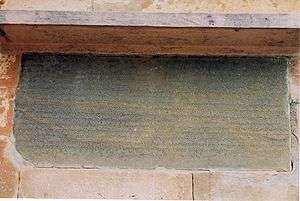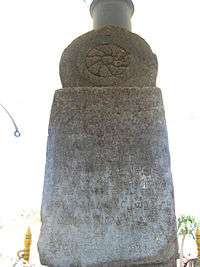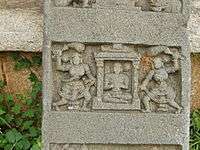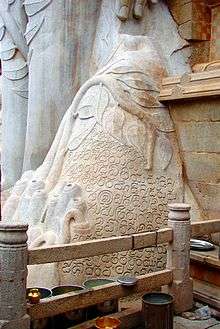Kannada inscriptions


About 25000 inscriptions found in Karnataka[1] belongs to Kannada rulers like Kadambas, Western Ganga Dynasty, Rashtrakuta, Chalukya, Hoysala and Vijayanagara Empire. Many inscriptions related to Buddhism and Jainism are unearthed. The inscriptions generally found are on stone (Shilashasana) or copper plates (Tamarashasana). The Kannada inscriptions (Old Kannada, Kadamba script) found on historical Hero Stone, coin and temple wall, piller, tablet and rock edict. The inscriptions found are in Proto Kannada, Pre Old Kannada, Old Kannada, Middle Kannada and New Kannada.
Earliest Kannada inscriptions


The first written record in Kannada traced to Ashoka's Brahmagiri edict, Tagarthi inscription dates back to 350 BC,[2] Nishadi Inscription of 400 AD of Chandragiri hill (Shravanabelagola), Halmidi inscription of 450 AD and Aihole inscriptions are very important in the history of Kannada and Karnataka. 5th century Tamatekallu inscription of Chitradurga and 500 CE Chikkamagaluru inscription. There are few Kannada words found in the edicts and inscriptions those are prior to the Christian era in places as far as Egypt.
- Brahmagiri rock inscription of Ashoka
Ashoka rock edict at Brahmagiri in Chitradurga district is the ancient site of Ishila. An inscription there contains this most ancient Kannada word. The earliest recorded word of Kannada is Isila occurring in the Brahmagiri rock inscription of 252 BC (similar to many other inscriptions with Kannada words).[3]
- Tagarthi inscription
A Dr. S. Shettar completed a detailed palaeographic study over 10 years, finding five to six inscriptions that are older than Halmidi inscription (in Poorvada Halegannada dialect). The inscription is a mix of Brahmi, Kannada and Nagari scripts. One of those found at Tagarthi (within the Gangavadi region in Shimoga district) dates to 350 AD, during the Ganga dynasty. This study pushed the date push back by at least a century. The historian Suryanath Kamath also agree with the findings of Dr S. Shettar.[4]
- Gunabhushitana Nishadi inscription
M. G. Manjunath an epigraphist Mysore based scholar discovered 400 AD Gunabhushitana Nishadi inscription of Jainism one of the 271 inscriptions on Chandragiri hill of Shravanabelagola found near Parshwanatha Basadi, which is 50 years older than Halmidi inscription. It is mentioned in the Epigraphia Karnataka. There are Prakrit, Sanskrit and Purvada Halegannada (Old Kannada words. The four lined inscription has six words. The inscription is in Shatavahana Brahmi and Aadi Ganga script. M. Chidananda Murthy also agree that Gunabhushitana Nishadi Shasana was a Kannada inscription (in Purvada Halegannada script).[5]
- Halmidi inscription
The 450 AD Halmidi inscription 16-line earliest Kannada inscription found at Halmidi in Belur taluk of Hassan district on rectangular sandstone ( 2.5 ft height and 1 ft width) has a Vishnu Chakra on its top. The language of the inscription is in Poorvada Halegannada ( Proto-Kannada). Archaeologist M. H. Krishna found the Brahmi script in the inscription. Shifted the inscription to Archaeological Museum, Mysore and later to Government Museum in Bangalore. Epigraphia Karnataka has dedicated a chapter to study of the inscription. The linguists and writers Govinda Pai, M. Chidananda Murthy, T. V. Venkatachala Sastry, Ram Sri Mugali, R.S. Panchamukhi, D.L. Narasimhachar, and M. M. Kalburgi studied the inscription and published papers. Writers including G. S. Gai, T. A. Gopinatha Rao, T. N. Srikantaiah, Shivarama Aithala, S. Nagaraju, S. Srikanta Sastri, M. Mariyappa Bhatta, M. B. Neginahal, K. V. Ramesh, Devarakondareddy and K. M. Hanumantha Rao have discussed the important issues raised by Halmidi inscription in their books.[6]
- Tamatakallu inscriptions
Chitradurga district is home for most ancient inscriptions written in archaic Kannada script. As per epigraphist Dr. B. Rajashekharappa the inscriptions known as Veeragallu at Tamatakal village written in Kannada script belongs mostly to end of Fifth Century or beginning of Sixth Century, describes the nature and achievements of Gunamadhura who ruled Masikapura (ancient name of Tamatakal), he was frivolous, generous and kind person. he was a favourite among women (Despite being of dark complexion), because of his kind nature. In 1903 by the historian late B. L. Rice discovered the inscriptions, Dr. Rajashekharappa found new aspects[7] .
Karnataka inscriptions of Kannada dynasties
The Karnataka inscriptions are maily categoried as mentioned below
- Kadambas inscriptions
- Halmidi inscription - Kadamba Coins and the earliest Kannada inscription
- Talagunda pillar inscription
- Halasi Inscriptions of Kadambas of Halasi
- Chandravalli rock inscription.
- In AD 475-490 Mrigesavarman of Kadambas of Halasi inscrption there is mention about Yapaniya.
- Western Ganga Dynasty inscriptions

- The 981 CE Old Kannada inscription at Vindyagiri Shravanabelagola
- Doddahundi nishidhi inscription
- Atakur inscription
- The 983 CE Tyagada Brahmadeva Pillar at Shravanabelagola
- Shravanabelagola inscription of Nandisena
- Tumbula inscriptions of 444 AD, Sanskrit-Kannada inscription, the Kannada words are used to describe the land boundaries.
- Western Ganga Kannada writings
- Chalukya inscriptions
- The 634CE Aihole inscription of Ravi Kirti (minister and poet of Badami Chalukya Pulakeshin II) available at the Meguti temple, the inscription is a eulogy of Pulakeshin II and his conquests.
- Mahakuta Pillar
- Kappe Arabhatta
- Badami Inscriptions
- Gadag inscription of Vikramaditya VI
- Sudi Inscriptions
- 610AD Peddavaduguru inscription of Pulakeshin II
- Rashtrakuta inscriptions
- Kavirajamarga
- Ninth century Kannada stone inscription of Rashtrakuta period unearthed near Tumbi Kere (tank) at Halekumur village in Byadgi takuk. The inscription is about Rashtrakuta rulers donating 200 acres to Siddarevar Singh to construct a tank.[8]
- Navalinga Temple inscriptions Kuknur.
- Northernmost Kannada inscription of the Rashtrakutas of 964 AD is the Jura record found near Jabalpur in Madhya Pradesh.
- Inscriptions related to Dantidurga
- Hoysala inscriptions
- Vijayanagara Empire inscriptions
Kannada copper plates and manuscripts
- The 8th century AD oldest Kannada copper plate inscription found at Belmannu in Karkala taluk of Udupi district.
- Western Ganga Dynasty Tumbula inscriptions of 444 AD
- The 8th century AD Aluvarasa II of Alupas copper plate inscription in Kannada.
- The 1430 AD Vijayanagara empire Devarajapuram copper plate inscription having state-deity Virupaksha's signature at the bottom in Kannada script to certify a grant of land to Brahmins (by King Devaraya II (1425-1446)).
Coins bearing Kannada inscription

- The 5th Century copper coin in archaic Kannada script' found at Banavasi.[9] One side has five letter inscription Sri Manaragi and symbol of Ujjain on other side.
- Coins bearing Kannada inscription
- Pagodas and Fanams with kannada inscription were the coinage of Alupas.
- Kadamba Coins
- Lari (fish hook money)
- Sudi and Lakkundi coins mint (Tankhashaley)
- Honnu or Gadyana of Hoysala
- Kalachuri Kannada Coinage
Kannada inscriptions found out side Karnataka
Many Kannada inscriptions found out side Karnataka mainly Maharashtra, Tamil Nadu and Andhra Pradesh.
- Andhra Pradesh[10]
- Kannada inscription of Gooty in Andhra Pradesh.
- At Tirumala Venkateswara Temple at Tirupati there are about 50 inscriptions available in Telugu and Kannada.
- Inscription (in Telugu-Kannada script) of Vijayanagara empire found at Kadimetla in Yemmiganur mandal of Kurnool district.[11]
- The 10th century AD. Copper plates of Amma II of Eastern Chalukya in Telugu-Kannada script available at National Museum New Delhi.
- The 15th Century Rare inscription traces route to Tirumala written in Kannada found in a mango orchard in Krishnampalle of T. Kammapalle panchayat (in Pullampet mandal) in Kadapa district. The inscription with the portrait of Tallapaka Pedda Tirumalarayudu (eldest son of saint lyricist Tallapaka Annamacharya) and Sankham, Chakram and Namam of Lord Vishnu.
- Other parts of the world
- The stone scripture found in Doleshwor of Nepal written in Kannada.
- Pyu sites of Myanmar yielded variety of Indian scripts including Kannada inscription.
- The Deopara inscription describes the Senas as Karnata Kshatriyas and Brahma-Kshatriyas.
Kannada inscriptions found in Maharashtra
- The Karhad copper plates in Kannada from Maharashtra is about after the defeat of Rajaditya in Takkolam the Krishna III's distribution of the raid of war; among his people at Melpadi military camp (Tamil Nadu) and also there is mention that Krishna III's invasion of the Chola territory was also to provide livelihood for his people.[12]
- Majority of the inscriptions found at Bombay (Mumbai) are in Prakrit, Sanskrit and few are in Kannada. Out of the inscriptions found two belongs to Chalukyas, one to Kadambas, two to Rashtrakutas, eight to Shilaharas, one to Yadavas of devagiri.[13]
- Shilaharas Kannada inscriptions, Silharas of Kolhapur used Kannada in inscriptions.
- Maharashtra is mentioned as Maharashtraka in 580 CE Chalukya inscription.
- Many historical inscriptions mentioned Kolhapur as Kollgiri, Kolladigirpattan, Kshullakpur Kollapur and Kollpur, particularly the word Kollpur originated from Kannada language.[14]
- Kannada inscriptions of Solapur district of Maharashtra
- Inscriptions at Ellora
- The 11th - 12th Century AD period Kannada Inscription of Chalukya Vikramaditya VI found at Beed Maharashtra
Kannada inscriptions found in Tamil Nadu
The Kannada inscription of Rashtrakuta king Krishna III period (of Tenth century CE) found at Melpadi village in Vellore district of Tamil Nadu. It is mentioned as the endowment was made in the presence of Krishna III's feudatories (Rattas and Bitti Raja of Melpadi). Krishna III was praised as Akalavarsha Deva, Prithvi Vallabha, Maha Rajathiraja, Parameshvara, Parama Bhattaraka and Chaleka Nallathan and it indicats that he was about to accomplish his conquests of Kancheepuram and Thanjavur.[15] The Kannada inscriptions found at Kanchipuram, Dharmapuri region, Vazhaithottam in Nilgiri District, Jain Palli at Alathur in Avinasi taluk, Coimbatore District and Karamadai copper plate inscription.[16] Avinashi Temple inscription in Coimbatore, Kanchi inscription of Vikramaditya, Sittannavasal inscription, Melpadi inscription of Rastrakuta Krishna III, Madras Kannada Herostone inscription, Kodumbalur inscription of Irukkuvelir Chiefs and Hero-stone inscriptions in Kondaharahalli are the inscriptions in Kannada.
Research institute of Kannada manuscripts
- Oriental Research Institute Mysore
- Oriental Research Institute & Manuscripts Library
- National Institute of Prakrit Studies and Research - Prakrit and Kannada manuscripts
People associated with Kannada inscriptions and manuscripts
- People associated with the study of Kannada inscriptions
- Shivakotiacharya's Vaddaradhane
- Nagavarma I
- Phakirappa Gurubasappa Halakatti
- Aluru Venkata Rao
- Parabrahma Sastry
See also
- Sritattvanidhi
- Kannada inscriptions in Karnataka
- Gazetteer of the Bombay Presidency
- Early epigraphy of Kannada
- Charition mime
- Shabdamanidarpana
- Epigraphy of old Kannada
- Extinct Kannada literature
- List of State Protected Monuments in Karnataka
- Kadamba script
- Modi script Hemadpant Hemadpanthi
- Telugu-Kannada script
- Nakara guild
- Sena dynasty Kannada Origin
- Linguistic history of the Indian subcontinent#History of Kannada
- Palaeography - India
- List of museums in Karnataka
External links
- Kannada inscriptions
- Pâli, Sanskṛit and Old Canarese Inscriptions from the Bombay Presidency and ... By John Faithful Fleet, James Burgess
- The Indian temple forms in Karṇātạ inscriptions and architecture
- Department of Ancient History and Archaeology Kannada University Hampi Karnataka
- Kannada Research Institute (KRI) Karnataka University Dharwad
- Ancient History and Archaeology Mysore Karnataka
- Temples of Karnataka
- Kannada inscriptions that mention Basavanna/Basaveshwara/Basavayya
- Inscriptions related to Vithoba
References
- ↑ "'Take up study on unearthed inscriptions'". Retrieved 2013-07-19.
- ↑ "Historians study pushes earliest record of Kannada writing back by a century". Retrieved 2013-07-19.
- ↑ "Confer classical language status on Kannada: Ananth Kumar". Retrieved 2013-08-05.
- ↑ "Historian's study pushes earliest record of Kannada writing back by a century". Retrieved 2013-08-05.
- ↑ "Mysore scholar deciphers Chandragiri inscription". Retrieved 2013-08-02.
- ↑ "Halmidi village finally on the road to recognition". Retrieved 2013-08-02.
- ↑ "Inscriptions kept in an open field.". Retrieved 2013-08-02.
- ↑ "Rashtrakuta stone inscription found". Retrieved 2013-07-22.
- ↑ "5th Century copper coin found at Banavasi". Retrieved 2013-07-22.
- ↑ "Jainism in Andhra Pradesh - Rashtrakuta and Chalukya inscriptions". Retrieved 2013-08-01.
- ↑ "Vijayanagara empire rock inscription found". Retrieved 2013-08-01.
- ↑ "Tamil, Kannada inscriptions found in Vellore village". Retrieved 2013-07-22.
- ↑ "A NOTE ON INSCRIPTIONS IN BOMBAY". Retrieved 2013-07-22.
- ↑ "Mahalaxmi Temple Kolhapur". Retrieved 2013-07-22.
- ↑ "Tamil, Kannada inscriptions found in Vellore village". Retrieved 2013-07-22.
- ↑ "Kannada script (10600)". Retrieved 2013-07-31.
![]() Media related to Kannada inscriptions in Karnataka at Wikimedia Commons
Media related to Kannada inscriptions in Karnataka at Wikimedia Commons
![]() Media related to Kannada inscriptions at Wikimedia Commons
Media related to Kannada inscriptions at Wikimedia Commons